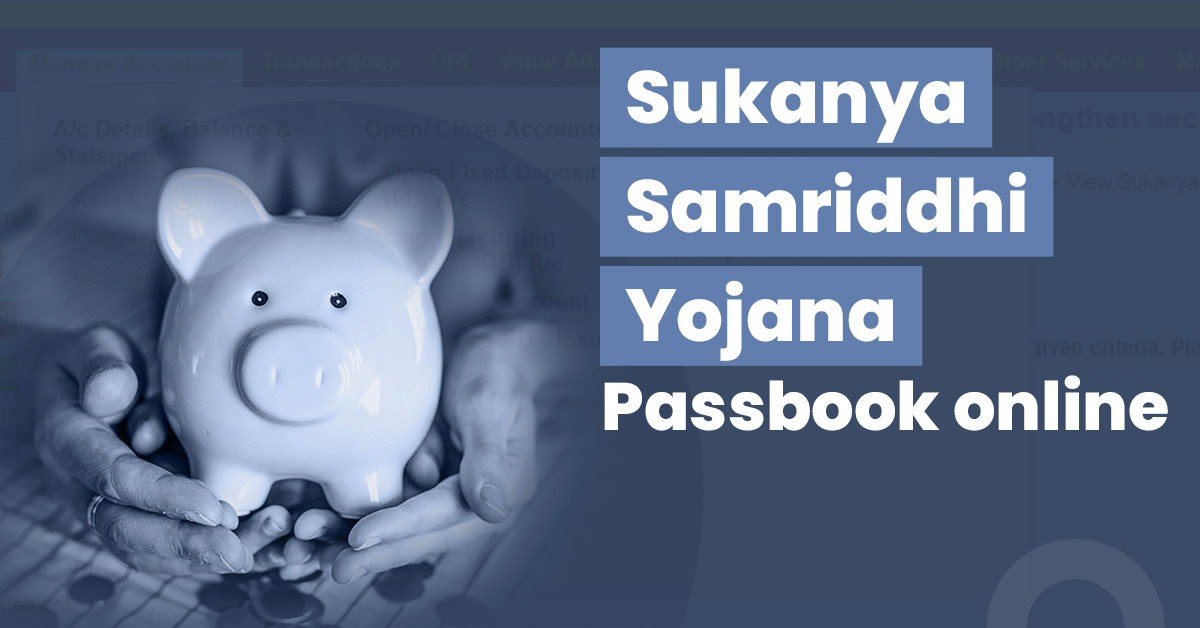How to Get Sukanya Samriddhi Account Passbook Online


The Government has taken various measures for the upliftment of women such as the ‘Beti Bachao Beti Padhao’ campaign launched in 2015. As part of the same campaign, the Sukanya Samriddhi Yojana (SSY) was introduced to ensure a financially secure future for the girl child.
The scheme comes with a tenure of 21 years and aims to help you create a corpus for your daughter’s education, marriage or future financial needs. Parents or legal guardians can open the SSY account in their daughter’s name. The scheme currently offers an interest rate of 8.2% compounded annually. The government fixes this interest rate on a quarterly basis.
After opening the SSY account, you can review the balance and check for past deposits using the passbook offered under the scheme. This passbook will be issued by the bank or post office where you open the account.
Moreover, the online service of Sukanya Samriddhi Yojana passbook allows you to keep a tab on your account updates from the comfort of any location. As with many financial services these days, you no longer need to go through the hassle of waiting in long queues to get your Sukanya passbook updated. So, let us give you a walkthrough of the Sukanya Samriddhi Yojana passbook online facilities.
Also Read: NSC in Post Office: Features, Interest rates, and Account Opening Process
How to Check the Balance Online for an SSY Scheme?
Most banks issue online credentials using which you can log into your SSY account and track the balance. These credentials are provided after you open the account. Here are the steps to check the balance in your SSY account online:
- Visit the net banking portal of the bank where your SSY account is being held.
- Log in using the credentials provided by the bank
- Your SSY account number and balance will be displayed on the home page. You can check the balance therein.
Some banks also offer mobile app-based services for the ease of customers. If your bank has a mobile application, you can check the account balance on your smartphone via the application.
However, not all banks or post offices offer an online facility for checking the Sukanya account balance. So, to check your balance offline, visit the post office or bank branch and enquire about the account balance.
You can also update your SSY passbook at regular intervals to know the balance in your account representing your deposits and the interest earned thereon.
Also Read: How Can I Check My Sukanya Samriddhi Account Balance Online?
Final Thoughts
The Sukanya Samriddhi Yojana scheme is a tax-saving scheme that will help to save money for your daughter’s future. It is a long-term saving scheme which requires regular investments every year. During the investment tenure, check your deposits and earned interests with the help of the Sukanya Samriddhi Yojana passbook .
Keep it updated to know the latest balance accumulated. You can also check the balance online or offline to track your investments’ performance.
FAQs about Sukanya Samriddhi Yojana passbook
What are the tax benefits of investing in the Sukanya Samriddhi Yojana Account?
The Sukanya Samriddhi Scheme is a tax-saving scheme which offers the EEE (exempt-exempt-exempt) benefit. This means you enjoy the following three tax benefits that help you create a tax-efficient saving corpus.
> The deposits made into the SSY account are allowed as a deduction from your taxable income under Section 80C of the Income Tax Act, 1961. You can claim a maximum deduction of Rs. 1,50,000 on your investments.
> The interest that you earn is exempted from tax under Section 10.
> The entire amount available at the time of withdrawal, principal plus interest earned, is is also tax-free.
Can I take a loan against my Sukanya Samriddhi Yojana Account?
No, there is no such option of obtaining a loan against the Samriddhi Yojana Account. But the parent or guardian is allowed to withdraw partially from SSY after the child attains 18 years of age and requires funds for studies.
Can I close my Sukanya Samriddhi Yojana Account before the account matures?
Yes, you can close your SSY account before maturity. This is called premature closure, and it is allowed under the following circumstances:
> If your daughter is getting married after 18 years of age
> In case of untimely demise of the girl child for whom the account was opened.
> If your daughter becomes a non-resident or a non-citizen of India, the account can be closed prematurely.
> If the account maintenance is causing hardship to your daughter, the post office or bank might allow premature closure. This hardship can be due to the parent’s death, medical reasons, etc. Moreover, closure is allowed only after five years of opening the account.
What is the minimum and maximum deposit amount into the Sukanya Samriddhi Yojana Account?
For each financial year, the minimum you can deposit in the account is Rs.250, while the maximum is Rs. 1,50,000. Remember that the minimum amount should be deposited annually to keep the account active. If the deposit is not made, an account can be revived by paying the minimum deposit amount of Rs 250 plus penalty amount of Rs 50 for each year of default.
What is the eligibility requirement to open the Sukanya Samriddhi Yojana account?
The following eligibility criteria should be met to open a Sukanya Samriddhi Yojana account:
> The girl child, who is the beneficiary, should be a resident Indian.
> The girl child should be below ten years of age.
> Only one account per girl child is allowed.
> A family can open a maximum of two SSY accounts, i.e. secure two girls under this scheme.
> In the case of twin girls, the guardian or parents can open a third account.




